SMR Techniques:
Quads Roll, T-Spine Roll, Delts Roll
Stretches & Functional Movements:
Wall Squat, Scaredy Cat, Handstand Kickup
Category: SMR
SMR Tip 10-18-2015
SMR Techniques:
Lats Roll, T-Spine Roll, Delts Roll
Stretches & Functional Movements:
Wall Squat, Scaredy Cat, Handstand Kickup
SMR Tip 10-17-2015
SMR Techniques:
Adductors Roll, Pecs Roll, Levator Press
Stretches & Functional Movements:
Supine Frogs, Supported Angels, Shifted Angels, Chin to Sternum, Chin to Clavicles, Chin to Shoulders
SMR Tip 10-16-2015
SMR Techniques:
Quads Roll, Piriformis Press, Glute Med Press
Stretches & Functional Movements:
Lunge and Reach, Pigeons, Cradles, Cross Over Toe Touch, Single Leg Deadlifts
SMR Tip 10-15-2015
SMR Techniques:
Lats Roll, Pecs Roll, SMR Butterfly
Stretches & Functional Movements:
Daisy Cow, Scaredy Cat, Cat Claw, Standing Pecs Twist, Halos, Floor to Sky
SMR Tip 10-14-2015
SMR Techniques:
Adductors Roll, ITB Roll, QL Roll
Stretches & Functional Movements:
Wall Straddle, Supported Corpse, Marching Corpse, Lateral Lunges
SMR Tip 10-13-2015
SMR Techniques:
Quads Roll, Feet Roll, VMO Roll
Stretches & Functional Movements:
Sumo Squat--Toes, Wall Lunge, Butt Kickers, Cradles
SMR Tip 10-12-2015
SMR Techniques:
Lats Roll, Calves Roll, Hamstrings Press
Stretches & Functional Movements:
Floor to Sky, Standing Nose to Knees, Superlunge
Which SMR Techniques Should I Do?
Click the techniques below to learn how to help your issue.
The 23 Fundamental SMR techniques are to be practiced at least once every two weeks for each technique, but more often will be necessary for some areas. The Fundamentals include the 3 Primaries and the 20 Secondaries.
The 3 Primary SMR Techniques are to be practiced at least once a week. More often is likely to benefit you more.
1st Primary -- Quads Roll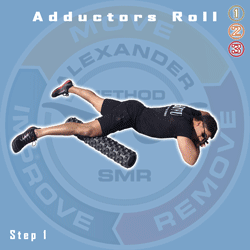
2nd Primary -- Adductors Roll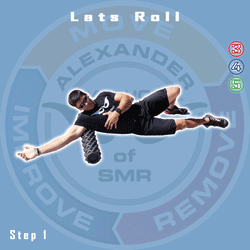
3rd Primary -- Lats Roll
The 20 Secondary SMR Techniques are to be practiced at least once for each technique every two weeks as an assessment. More often is likely to benefit you for some techniques, but you should never ignore an area for more than a couple weeks before inspecting it again to ensure you aren't skipping a problem when it is small and relatively easy to fix. 
1st Secondary -- Calves Roll
2nd Secondary -- Foot Roll
3rd Secondary -- Hamstrings Roll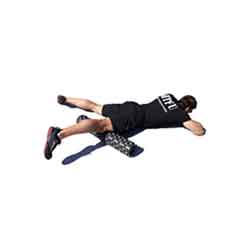
4th Secondary -- VMO Roll
5th Secondary -- IT Band Roll
6th Secondary -- Glutes Roll
7th Secondary -- Piriformis Roll
8th Secondary -- Iliopsoas Roll
9th Secondary -- QL Roll
10th Secondary -- Pecs Roll
11th Secondary -- T-Spine Roll
12th Secondary -- Delts Roll
13th Secondary -- Levator Floor Press
14th Secondary -- SMR Butterfly
15th Secondary -- Neck Roll
16th Secondary -- Sterno Roll
17th Secondary -- Triceps Roll
18th Secondary -- Biceps Press
19th Secondary -- Extensors Roll
20th Secondary -- Flexors Press
|
The 47 Extended SMR techniques are to be practiced as needed when dealing with a issue in that area of your body (normally two or three techniques per day). These techniques are meant to be done almost daily when you have an issue in that region (and ONLY when you have an issue in that region).
1st Extended -- Gastroc Roll
2nd Extended -- Pop Press
3rd Extended -- Post Tib Press
4th Extended -- Peroneals Wall Roll
5th Extended -- Peroneals Wall Press
6th Extended -- Peroneals Floor Roll
7th Extended -- Peroneals Floor Press
8th Extended -- Shin Wall Roll
9th Extended -- Shin Wall Press
10th Extended -- Shin Floor Roll
11th Extended -- Shin Floor Press
12th Extended -- Arch Roll
13th Extended -- Arch Press
14th Extended -- Foot Press
15th Extended -- Toes Press
16th Extended -- Hamstrings Press
17th Extended -- Seated Adductor Press
18th Extended -- Prone Adductor Press
19th Extended -- IT Band Press
20th Extended -- Quads Press -- Single Ball
21st Extended -- Quads Press -- Double Ball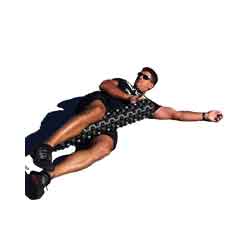
22nd Extended -- The Cricket
23rd Extended -- Glute Med Press
24th Extended -- Piriformis Press
25th Extended -- TFL Roll
26th Extended -- TFL Press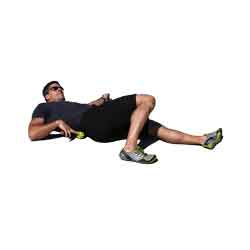
27th Extended -- QL Press -- Single Ball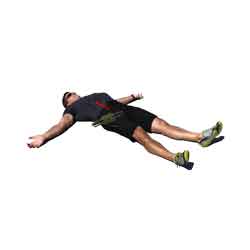
28th Extended -- QL Press -- Double Ball
29th Extended -- Sacrum Press
30th Extended -- Iliacus Press
31st Extended -- Psoas Press
32nd Extended -- Pecs Hand Press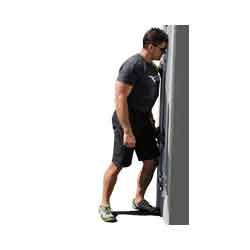
33rd Extended -- Pecs Wall Press
34th Extended -- Pecs Floor Press
35th Extended -- Neck Press
36th Extended -- Scalenes Press
37th Extended -- Sterno Press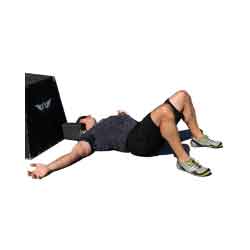
38th Extended -- Levator Wall Press
39th Extended -- Infra Press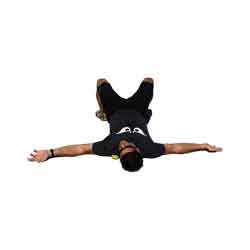
40th Extended -- Supra Floor Press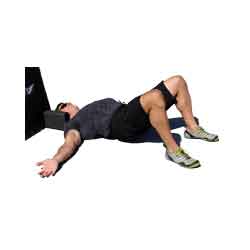
41st Extended -- Supra Wall Press
42nd Extended -- Subscap Press
43rd Extended -- Serratus Press
44th Extended -- Delts Press -- Wall
45th Extended -- Delts Press -- Floor
46th Extended -- Brachi Press
47th Extended -- Extensors Press
|
|
Take 2-5 minutes for each SMR exercise per side of your body. This will provide enough time under tension to stimulate the GTO and your muscles will likely relax more, allowing you to make quicker progress toward full range pain-free movement. Quicker movements tend to stimulate the muscles, whereas slower movements tend to relax them. You may need significant SMR work in a particular area. Work through all 70 of the SMR techniques as needed, plus the nearly 90 stretches to address every skeletal muscle in your body. Over time you should need these techniques less often and it should take less time with each technique to get the release you are seeking. |
| **All information is provided for educational purposes only. You should consult your doctor before attempting any exercises you read on this page or any page on this website.** |
When Do I Practice SMR?

Many of us "out there" do not know when we need to practice a little SMR, or instead a little stretching, or when we should go harder with our workouts, or when we should take a recovery day, etc.
We will not answer all of your training related questions in this post, but we will begin the decision-making process for when to stretch or practice SMR prior to your workout by providing a nifty little flowchart you can refer to when you are beginning your warm up.
 If you can stretch properly and lengthen all of your muscles without any massage work, then your body is working as it should. Simply continue doing whatever it is you are already doing! It's like the saying, "If it isn't broken, don't fix it!" You should stretch and exercise regularly. If you are fully capable with only these two elements in your schedule then you do not need to seek additional methods and assistance.
If you can stretch properly and lengthen all of your muscles without any massage work, then your body is working as it should. Simply continue doing whatever it is you are already doing! It's like the saying, "If it isn't broken, don't fix it!" You should stretch and exercise regularly. If you are fully capable with only these two elements in your schedule then you do not need to seek additional methods and assistance.
 We must stress the need to conduct an assessment of whether or not you truly have the Range Of Motion (ROM) to do all the things you wish to do in your life. To do this assessment you will not need any special knowledge, equipment, or training (no, you do not need a wired hat like in the picture above).
We must stress the need to conduct an assessment of whether or not you truly have the Range Of Motion (ROM) to do all the things you wish to do in your life. To do this assessment you will not need any special knowledge, equipment, or training (no, you do not need a wired hat like in the picture above).
Try to lift or move the normal things in your home or work life. Are these movements easy? Now try to move just a little farther than the ROM you need for those activities. You should be able to move much farther without a load than you can with the load, and well beyond the range you require for any movement (such as touching your toes or reaching straight overhead).
 Instead of challenging themselves to maintain or increase their ROM, many people simply make excuses to no longer do certain activities because they hurt or they have a mistaken belief that the movement in-and-of-itself is dangerous (like squatting below parallel or running is bad for you).
Instead of challenging themselves to maintain or increase their ROM, many people simply make excuses to no longer do certain activities because they hurt or they have a mistaken belief that the movement in-and-of-itself is dangerous (like squatting below parallel or running is bad for you).
We believe quitting is bad! We want to help you find ways to learn or revisit activities without injuring yourself. Scaling the ROM, loads, and repetitions in any program is almost always a must at times, especially in the beginning, but quitting should never be your answer. If you do not know how to modify your movements to make them safe, hire a personal trainer to guide you.
 So how do you know when to stretch, exercise, practice SMR, or seek the help of a qualified professional? The flowchart above makes it simple. The text below walks you through it...
So how do you know when to stretch, exercise, practice SMR, or seek the help of a qualified professional? The flowchart above makes it simple. The text below walks you through it...
- Start moving.
- Feel stiff and restricted?
- Stretch and do some light exercises.
- Still feel stiff and restricted?
- Practice some SMR and more stretching/light exercise for the tight areas.
- Still feel stiff and restricted?
- Are you hydrated? (especially hydrated with balanced electrolytes)
- If you are capable of safely performing the movements in the workout, proceed. If not, contact your local hands-on therapist to get the help you need. Here is a link to help you find some local therapists.
Does this list cover everything you need to know about self care? No. Does every problem have a complicated answer. No. Some of the simple things that will solve your problem you are not in the habit of doing. The most common cause to movement limitations in the gym that we've found in over twenty years of instruction is the lack of effort a person makes into changing the bad habits they have. Start with hydration. Add some stretching. Move in ways you might not be doing while you are at work. Limber up those joints and extend your reach just a bit outside your comfort zone. When stretching is not improving your ROM, add in massage work (both on your own and with a professional). If that isn't solving your movement limitations, then take it a step farther but with professional guidance. Take a concerted interest in your own health and well-being. It is not the physician's job to be your nanny and clean up after all of your mistakes. You need to clean up some of them yourself.
You just might be surprised by how much you can improve your quality of life by diligently practicing your SMR homework, some complimentary stretches, and keeping yourself hydrated. Take it one day at a time. Now go take care of yourself!
